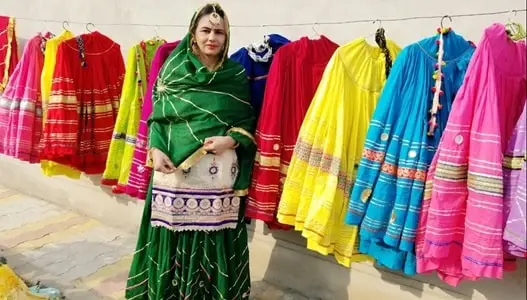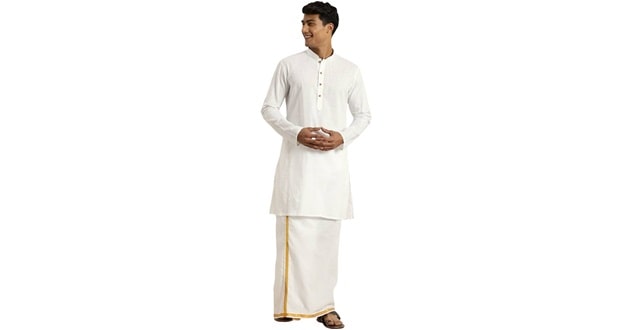Punjab has a rich cultural heritage. Its diversity and uniqueness are depicted in the state’s traditional dress. The state is filled with high-spirited people whose best expression is through their traditional garments. Here is a list of the traditional Punjabi dress codes for men and women.
Traditional dress of Punjabi women
1. Punjabi Ghagra

This dress is a compact set of four-piece costumes. It comprises a kurta, a long-flared skirt known as Ghagra, a typical Punjabi-fashioned salwar or trouser, and a Pulkari head scarf. Women in Punjab wear this colorful traditional dress while performing Giddha, a traditional folk dance.
2. Patiala Salwar Suit
The name Patiala is derived from one of the popular cities in Punjab. This unique suit comprises baggy, loose-style pleated trousers paired with a short kurti and a phulkari dupatta. It is a functional attire for all Punjabi women. It is a very comfortable and airy dress to wear. This suit was part of the royal family’s outfit in ancient times.
3. Churidar Suit
Churidars consists of a tunic or kameez and a typical tight-fit trouser worn at the lower bottom. They are designed to hug the legs and eventually look incredible. The material is sussi cotton and comes in a variety of different colors. Another name for churidar is full-length Ghuttana.
4. Phulkari Suit/jacket
Pulkari means Flower crafting. It is an expert technique used by Punjabi women to make jackets using vibrant threads. Jackets worn with Pulkari showcase Punjab’s rich culture. They are often worn on festivals and special occasions.
5. Parandi
Parandi is a long cluster of silk threads of vivid and attractive colors. There are four parandi types: Jalebi Parandi, Moti Parandi, Laddoo Parandi, and Jail Parandi. It is a sign of beauty and love. Women with long hair bread and wear this parandi at the lower end of their hair. The charming parandi has embellishments like zari, mirrors, small metallic balls, and pearls. A golden ribbon, “Gota,” is wrapped around the parandi to make it appealing.
Traditional Dress of Men in Punjab
1. Tehmat
Tehmat is a kind of dhoti or lungi with a glossy texture and zari border. Men in punjab pair Tehmat with a short kurta or a shirt that looks stunning. It is worn with unique folds at the front. Punjabi men wear Tehmat on special occasions or while performing bhangra, a famous folk dance of Punjab.
2. Jama
Jama is a traditional gown worn by Punjabi men since the Mughal Period. “Jora jama” means cloth given by the maternal uncle to the groom. However, ancient people used this conventional attire during ancient times. A unique shawl named jamawar’ and a majestic Turban give a royal look and can be worn by both male and female.
3. Kurta Pyjama
One famous traditional Punjab outfit Punjab is a simple kurta and pajama. The kurta is a long piece of cloth worn until the knees, while the pyjama is a loose pant with a drawstring.
4. Pagadi (Turban)
Pagadi is a traditional headgear for Punjabi men. It is also known as “Pag.” Pag is made of cotton and is comfortable to wear during summer. This remarkable fabric is tied on the head of Punjabi using a specialized winding technique. Sikh turbans are the ‘dastar’. A young Sikh boy ties a turban for the first time at the Sikh temple “Gurudwara.” This ceremony is called the Dastar/ Pagdi bandhi rite.
5. Jutti (traditional shoes)
Punjabi Jutti has been a part of the royal king’s family for over 400 years. It is traditionally made from leather with gold or silver threads. One mind-blowing fact about Juttis is that there is no right and left side distinction and that they can be worn on any foot. Both men and women can wear this traditional accessory.
Conclusion
The traditional costumes of Punjab are a blend of comfort, beauty, and excellent bright colors. Just like the awesome vibe of Punjab, their attire is equally beautiful and elegant. Whether it’s the iconic pagri or the jutti, every element adds a touch of tradition and heritage. Even with modern influences, Punjabi clothing continues to be a significant part of the state’s identity.

